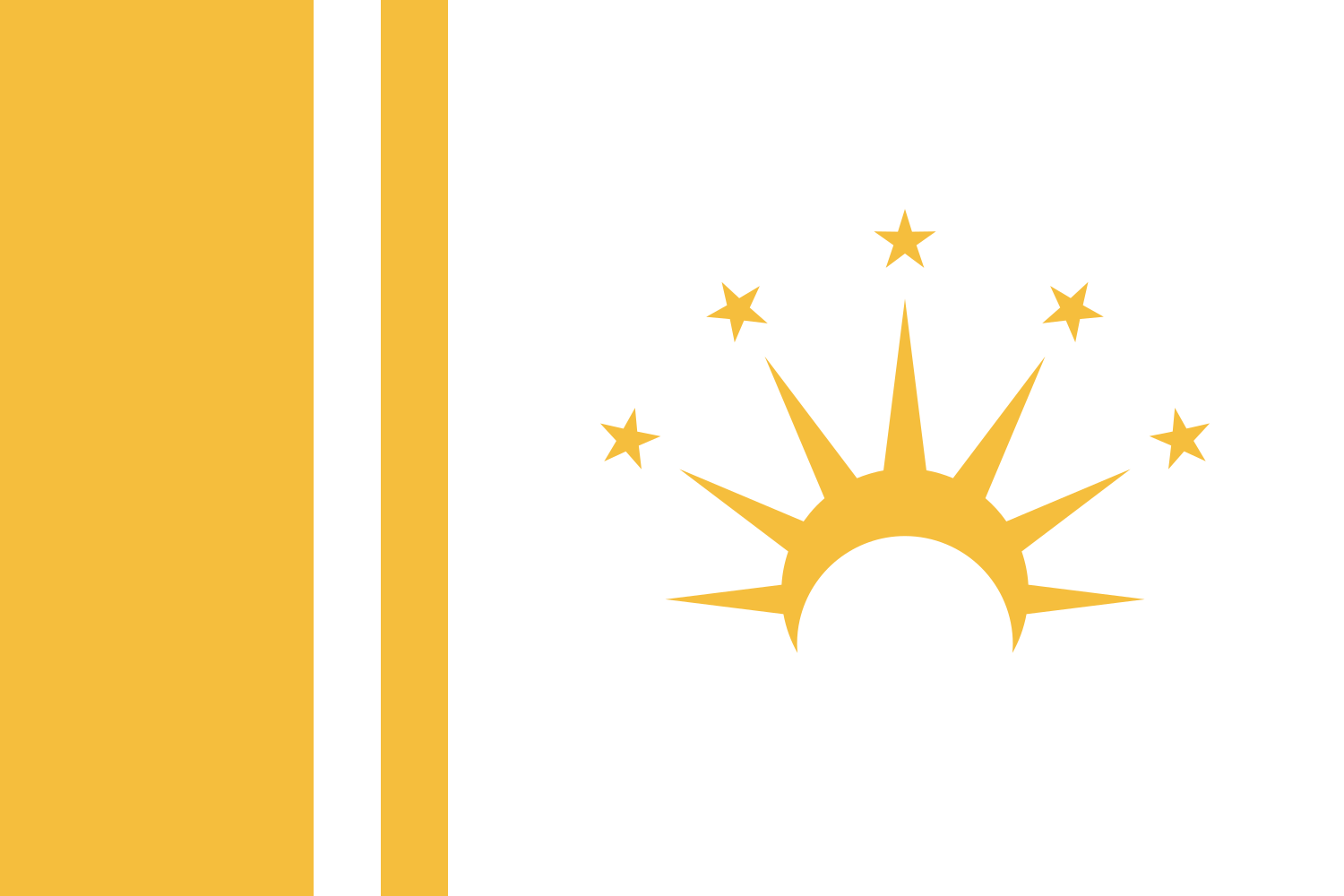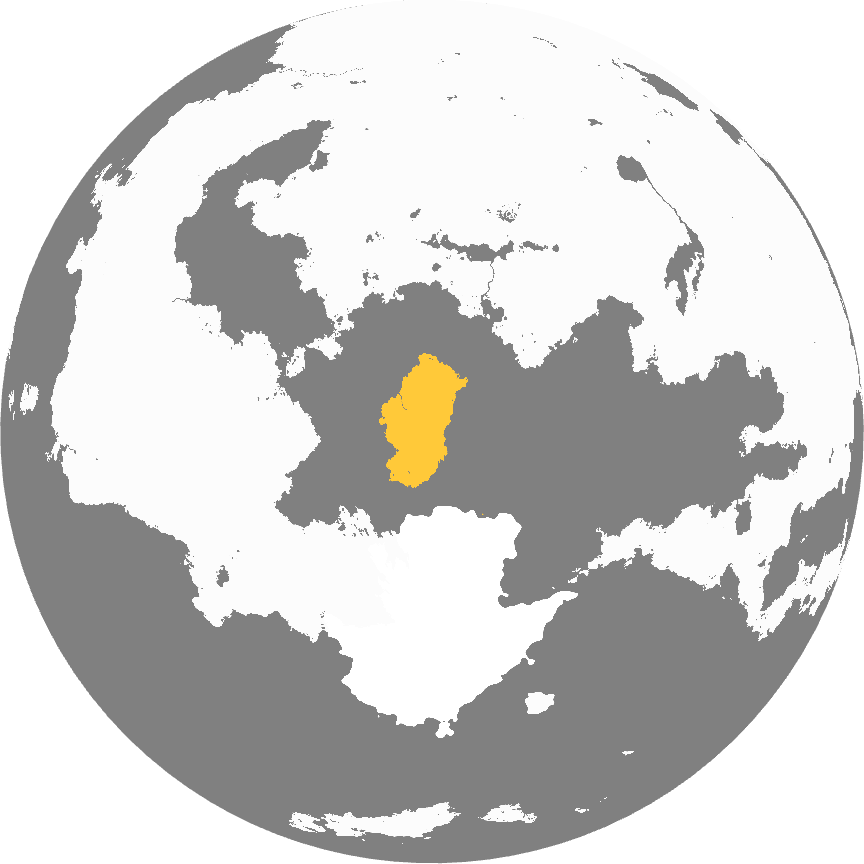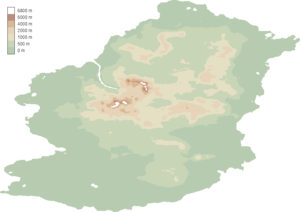Ikonia: Difference between revisions
No edit summary |
No edit summary |
||
| Line 22: | Line 22: | ||
== Etymology == |
== Etymology == |
||
| − | Usually applied only to the Ikonic mainland, the name ''Ikonia'' comes from the old Spearkan ''Ikon'', meaning a visual representation of an object, scene or abstraction. During the reformation of the nation, this was deemed as an appropriate sobriquet, as the cantons represented an |
+ | Usually applied only to the Ikonic mainland, the name ''Ikonia'' comes from the old Spearkan ''Ikon'', meaning a visual representation of an object, scene or abstraction. During the reformation of the nation, this was deemed as an appropriate sobriquet, as the cantons represented an idealized image of historical life. The adjective "Ikonic" is commonly used to refer to matters relating to the Ikonic Federation as a whole, and is used in law to refer to citizenship and nationality. |
| + | |||
| + | Whilst the name Spearka is no longer officially recognized, many citizens still use the moniker to refer to the island as a whole, or to elements of cultural history. Spearka is still occasionally used erroneously by foreign powers and individuals. |
||
| + | |||
| + | In 2113, a campaign was launched to reinforce the nations new official title. Local councils distributed flyers and aired television segments that encouraged people to embrace the new name, using the now infamous slogan 'Don't be moronic, go Ikonic!'. The campaign received enormous backlash and was a political disaster for the Lumian Prime Isidore Wexel, who orchestrated the campaign, and he was excommunicated from his monastery. The slogan was criticized for being culturally insensitive and demeaning of traditional Spearkan values. However, the campaign succeeding in raising awareness for the new title and cementing its legality. |
||
== History == |
== History == |
||
| Line 39: | Line 43: | ||
=== Weather === |
=== Weather === |
||
| − | Ikonia is host to an abnormally varied range of weather phenomena. For reasons that are still unknown to science, the island sees frequent rainstorms, snowstorms, thunderstorms, hailstorms, tsunamis, lightning, derecho wind storms, cases of mass hysteria, ball lightning, anticyclonic typhoons, hurricanes, tornadoes, sandstorms, whirlpools, incidents of raining fish, flash floods, firestorms, and a cumulonimbus cloud suffering from insular dwarfism that orbited the island dropping condensed bombs of hyper-hail that lasted for two months. |
+ | Ikonia is host to an abnormally varied range of weather phenomena. For reasons that are still unknown to science, the island sees frequent rainstorms, snowstorms, thunderstorms, hailstorms, tsunamis, lightning, derecho wind storms, cases of mass hysteria, ball lightning, anticyclonic typhoons, hurricanes, tornadoes, sandstorms, whirlpools, incidents of raining fish, flash floods, firestorms, and a semi-sentient cumulonimbus cloud suffering from insular dwarfism that orbited the island dropping condensed bombs of hyper-hail that lasted for two months. |
Meteorologists remain baffled by these events. The IFGS (Ikonic Federation Geographic Society) have officially theorized that these freak incidents may be a product of the massively altered weather systems within each state due to the enormous size of the canton megastructures. |
Meteorologists remain baffled by these events. The IFGS (Ikonic Federation Geographic Society) have officially theorized that these freak incidents may be a product of the massively altered weather systems within each state due to the enormous size of the canton megastructures. |
||
| Line 50: | Line 54: | ||
=== States === |
=== States === |
||
Like its predecessor, Ikonia is divided into semi-autonomous states, though Ikonia is comprised of six rather than seven: Nexus, Oltum, Arcaros, Valora, Lumia and Advan. The former seventh state, Bastion, was turned into the Bastion Proving Grounds and is now the heart of Ikonic industry. |
Like its predecessor, Ikonia is divided into semi-autonomous states, though Ikonia is comprised of six rather than seven: Nexus, Oltum, Arcaros, Valora, Lumia and Advan. The former seventh state, Bastion, was turned into the Bastion Proving Grounds and is now the heart of Ikonic industry. |
||
| − | |||
| ⚫ | Each state has an elected leader referred to as the "Bearer", the exception to this is Nexus, who instead is governed by the leader of Ikonia, referred to as the "Apex". Each state has a number of monasteries that devote themselves to the production of edified individuals who embrace the traditions of their respective canton. Nexus has no canton of its own, and therefore no monasteries or Primes. They do not put forward a potential bearer to become the Apex. Instead, they are governed locally by the Apex himself who resides in Nexus. Each monastery then elects a "Prime", who serves as the monastery's representative. The Bearer of the |
||
==== Nexus ==== |
==== Nexus ==== |
||
| Line 73: | Line 75: | ||
==== Bastion Proving Grounds ==== |
==== Bastion Proving Grounds ==== |
||
| − | Bastion was once the centre of the Federations military, focusing on the production of weapons and military technologies. Great shipyards lined the Baske and Elohim rivers, and the eastern region of the state was also home to three launchpads intended for launch of ground-to-space missiles or military spacecraft. During the reformation, Bastion was depopulated, and the entire state was reconsecrated to heavy industry, as well as test sites for both civil and military technologies. The region is officially referred to as the Bastion Proving Grounds, more commonly pronounced as 'Bazprog'. Virtually all of Ikonia's automobiles, military equipment, aircraft and weapons are tested at Bazprog. In addition to test sites, Bazprog is also exploited for its rich deposits of ore and precious metals, making it the centre of virtually all Ikonic heavy industry. Miles of canals, mineshafts and maglev tracks criss-cross the landscape |
+ | Bastion was once the centre of the Federations military, focusing on the production of weapons and military technologies. Great shipyards lined the Baske and Elohim rivers, and the eastern region of the state was also home to three launchpads intended for launch of ground-to-space missiles or military spacecraft. During the reformation, Bastion was depopulated, and the entire state was reconsecrated to heavy industry, as well as test sites for both civil and military technologies. The region is officially referred to as the Bastion Proving Grounds, more commonly pronounced as 'Bazprog'. Virtually all of Ikonia's automobiles, military equipment, aircraft and weapons are tested at Bazprog. In addition to test sites, Bazprog is also exploited for its rich deposits of ore and precious metals, making it the centre of virtually all Ikonic heavy industry. Miles of canals, mineshafts and maglev tracks criss-cross the landscape, extending even beyond the sea in the form of off-shore platforms and undersea pipelines. |
== Politics == |
== Politics == |
||
=== Government === |
=== Government === |
||
| ⚫ | Each state has an elected leader referred to as the "Bearer", the exception to this is Nexus, who instead is governed by the leader of Ikonia, referred to as the "Apex". Each state has a number of monasteries that devote themselves to the production of edified individuals who embrace the traditions of their respective canton. Nexus has no canton of its own, and therefore no monasteries or Primes. They do not put forward a potential bearer to become the Apex. Instead, they are governed locally by the Apex himself who resides in Nexus. Each monastery then elects a "Prime", who serves as the monastery's representative. The Bearer of the state is then elected from this candidacy of Primes. However, it is worth noting that the population votes on the monastic party and not the Prime themselves, as the monastery can elect a new Prime internally whenever they deem necessary. The number of monasteries within each state varies, with an average number of registered Primes across all the states being around 50. Arcaros has the most, with 83 monasteries, whilst Oltum has the fewest at a mere 18. Lumia has 39, Valora has 61, and Advan has 24. |
||
| − | [[File:Buffet.mp3]] |
||
| + | |||
| − | Each canton is managed and sustained by |
+ | Each canton is managed and sustained by the real-world population of each respective state, known as the citizenship. These groups learn and seek guidance from the ways of their canton inhabitants. They subscribe to the same philosophies and aspire to think the same way. Each group votes on a representative named the ‘Bearer’, whose role is to speak on behalf of their canton. Each representative is selected from a pool of people who live a monastic and meditative life, attempting to quash all traces of their own individual personality in favor of promoting the influence of their canton. Bearers are elected through a monastic party system. Each monastery has their own interpretation of their canton’s values, and decides internally upon a candidate known as a "Prime". The populace of each state then votes on which monastic party should represent them. Bearer elections are held every 3 years. Monastic elections are held whenever the monastery wishes. |
National legislation is passed by the Great Council, which is made up of the Apex and the five Bearers of each canton. The Apex is the head of state, but does not have absolute control. They are given two votes. Bearers get one vote. The Apex is elected by the population of Nexus. The acting Apex does not get to vote in the general election. General Elections are held either every 5 years, or if the other Bearers reach a unanimous agreement that the current Apex must retire. |
National legislation is passed by the Great Council, which is made up of the Apex and the five Bearers of each canton. The Apex is the head of state, but does not have absolute control. They are given two votes. Bearers get one vote. The Apex is elected by the population of Nexus. The acting Apex does not get to vote in the general election. General Elections are held either every 5 years, or if the other Bearers reach a unanimous agreement that the current Apex must retire. |
||
Revision as of 14:52, 13 July 2023
|
Ikonia
|
|||||
|---|---|---|---|---|---|
 |
|||||
| Motto | "Tempus, officium sapientiae" (Time, progenitor of wisdom) |
||||
| Common Name | Ikonia | ||||
 |
|||||
| Demonym | Ikonic | ||||
| Official languages | Highkonic | ||||
| Currency | Beans | ||||
| Politics | |||||
| Capital | Nexus | ||||
| Government | Federal Republic | ||||
| Foundation | 23rd Century | ||||
| Preceded by | Spearka | ||||
| Demography | |||||
| Ethnicities | Spearkan 76.7% Felisk 9.4% Troak 6.5 Laythi 6.1% Other 1.3% |
||||
| Population | 4,741,183 | ||||
| Area | 14,993 km² km² | ||||
Not to be confused with Iconia.
Ikonia, officially the Ikonic Federation, and sometimes referred to as Old Spearka, is a country in Baskay-Caledon. Ikonia is distinguished by it's highly unusual and unique method of governance. Large areas of the island of Ikonia are dedicated to the sustainment of enormous arcological domes, known as cantons. These cantons contain populations of kerbals who are forced unwittingly to live as historical societies, which is then observed by the cognizant population to inform their political decision-making. Though the ethics of such a system are highly dubious, opposition to the Omnichronicratic program is small, as Ikonic census data reports high scores in the Kerbal Happiness Index (KHI) across all six states.
Etymology
Usually applied only to the Ikonic mainland, the name Ikonia comes from the old Spearkan Ikon, meaning a visual representation of an object, scene or abstraction. During the reformation of the nation, this was deemed as an appropriate sobriquet, as the cantons represented an idealized image of historical life. The adjective "Ikonic" is commonly used to refer to matters relating to the Ikonic Federation as a whole, and is used in law to refer to citizenship and nationality.
Whilst the name Spearka is no longer officially recognized, many citizens still use the moniker to refer to the island as a whole, or to elements of cultural history. Spearka is still occasionally used erroneously by foreign powers and individuals.
In 2113, a campaign was launched to reinforce the nations new official title. Local councils distributed flyers and aired television segments that encouraged people to embrace the new name, using the now infamous slogan 'Don't be moronic, go Ikonic!'. The campaign received enormous backlash and was a political disaster for the Lumian Prime Isidore Wexel, who orchestrated the campaign, and he was excommunicated from his monastery. The slogan was criticized for being culturally insensitive and demeaning of traditional Spearkan values. However, the campaign succeeding in raising awareness for the new title and cementing its legality.
History
| “ | - To procure utmost sagacity, one must gather wisdom from every realm. And verily, the pearls of wisdom from bygone times must be treasured and preserved, lest they be lost to oblivion. | ” |
| —-Kerdavor Rancos, 97 AD | ||
Geography
Climate
The vast majority of Ikonia's territory is situated in Bascay-Caledon. Ikonic overseas territories extends to the two islands, Ulkam and Yarva, a region of the Antarctic, and Fish Island.
Mainland Ikonia has a temperate to frigid climate, being situated between 52°S and 69°S of latitude. Annual mean temperatures vary from 4 °C (39.2 °F) in the south to 8 °C (46.4 °F) in the north. The verdant island is largely covered in grasses and common varieties of pine, with only a small number of endemic plant species. The Eastern coast of Ikonia is battered by powerful prevailing winds throughout the year, which are utilized in wind power generation systems along across the country. Conditions vary sharply further inland. The inner regions along the north and north-east are dry and temperate, with annual mean temperatures of 10 °C (50 °F). The central mountain range has a peak elevation of over 6,500m. The foothills and plains to the south are dry and cool, sustaining large forests of pine.
Weather
Ikonia is host to an abnormally varied range of weather phenomena. For reasons that are still unknown to science, the island sees frequent rainstorms, snowstorms, thunderstorms, hailstorms, tsunamis, lightning, derecho wind storms, cases of mass hysteria, ball lightning, anticyclonic typhoons, hurricanes, tornadoes, sandstorms, whirlpools, incidents of raining fish, flash floods, firestorms, and a semi-sentient cumulonimbus cloud suffering from insular dwarfism that orbited the island dropping condensed bombs of hyper-hail that lasted for two months.
Meteorologists remain baffled by these events. The IFGS (Ikonic Federation Geographic Society) have officially theorized that these freak incidents may be a product of the massively altered weather systems within each state due to the enormous size of the canton megastructures.
2125 Storm
On March 18 2125 at 3:08 p.m. in the skies above the northeastern coast of Nexus, a warm front collided with a cool air pocket situated over the Ikonic mainland, generating a squall line of cumulonimbus thunderheads that marched south towards the island. Atmospheric pressures in the surface low-pressure area recorded by the IFGS dropped to 1,003 hPa as the warm front punched through the core of the main squall, dissipating the majority of the thunderheads. However, by 5:15 p.m. the IFGS recorded an increase in meteorological activity centering around on the single remaining cumulonimbus cloud. By 5:41 p.m. the single storm cloud had intensified enormously as it fed upon the latent atmospheric energy of its dissipated brothers, though its physical size remained diminutive. At this point the cloud had grown to a height of only 3,100m (10,170 ft), but with internal updrafts exceeding 260 kph (161 mph).
At 5:58 p.m. the microscale storm made landfall. Central surface pressure beneath the storm lowered to 928 hPa. A thick curtain of hail pummeled the areas beneath the storm in a wet microburst, causing significant damage to properties and vehicles in the town of Sankrator. Bolts of lightning projected from beneath the base of the storm with an unusually high frequency, striking the masts of ships docked around the port of Sankrator. This started oil fires within the bay which inhibited rescue efforts for the crews of the vessels perforated by hail. By 6:20 p.m. the storm moved on from Sankrator and headed further inland. In its wake, 74% of properties within the area had been damaged or destroyed, and 37 of the town's 538 residents had perished.
States
Like its predecessor, Ikonia is divided into semi-autonomous states, though Ikonia is comprised of six rather than seven: Nexus, Oltum, Arcaros, Valora, Lumia and Advan. The former seventh state, Bastion, was turned into the Bastion Proving Grounds and is now the heart of Ikonic industry.
Nexus
Nexus is both the foremost state of Ikonia and the capital city. It was the seat of power in old Spearka. Its austere and cosmopolitan nature meant it was the perfect setting for the calculated leadership of Ikonia. The basic leadership structure of Spearka has been maintained, and the capital state has retained it's original name. Having no omnichronicratic megastructure-microculture of its own, Nexus has no monasteries, Primes or Bearer. Instead, it is the responsibility of Nexus to elect the Apex from the Bearers of the other five Cantons.
Oltum
Originally known as Osten. It's great green plains and unspoiled natural environment made it the ideal location for a hunter-gatherer society. The Prehistoric canton represents a time before recorded history, where decision-making would be guided by survival instincts, communal living, and a close connection with nature. While this canton offers a different perspective on decision-making, the absence of complex societal structures and limited knowledge could impact the range of choices available. The Oltumese canton is known as The Honua Kahiko.
Arcaros
Originally known as Verwelm. The tranquil beauty and mild lifestyle of the region made it the perfect home for philosophers and artists, who would rather discuss issues at length than actually act upon them. The Classical period was known for its advancements in philosophy, democracy, and the arts. Citizens of this canton might value rational thinking, debate, and civic engagement. They make decisions based on a deep understanding of ethical principles and political systems. The Arcaros canton is known as The Arcos Tholos.
Valora
The Agricultural origins of Elohim gave way to the feudal and martial society of Valora, where the fertile pastures and plentiful shores are toiled. Rarely, a vessel of exploration ventures into the deep waters and across the horizon.The Medieval period was characterized by feudal systems, chivalry, and religious influence. The decision-making in this canton is influenced by hierarchical structures, moral codes, and religious doctrines. However, the limitations on education and scientific progress during this period affect the range of available knowledge. The Valoran canton is known as The Impetum Sphaera.
Lumia
The bejeweled mountains and high altitude observatories of Baske gave rise to the illumination and optimism of Lumia. The Renaissance period witnessed a revival of learning, exploration, and artistic expression. Citizens of this canton might have a thirst for knowledge and a curiosity about the world. Decision-making could be influenced by intellectual inquiry, critical thinking, and a desire to advance scientific and cultural understanding. The revered inventor [ ] has constructed a number of primitive hydroelectric dams across Lumia, meaning the countryside hills ripple and shimmer with waterfalls and canvas. The Lumian canton is known as The Lumia Rotunda.
Advan
Originally known as Zimi. The eastern coastline is hammered by strong prevailing winds. Swathes of wind turbine farms line the cliffs like giant, stalwart defenders. This provides a limitless source of energy for the innovative and economical society of Advan, allowing their technologies and ideas to flourish without a reliance on fossil fuels. The Industrial period brought about significant technological advancements, urbanization, and industrialization. Citizens in this canton might prioritize efficiency, innovation, and economic development in their decision-making. However, they might also face challenges related to environmental and social consequences of rapid industrial growth. Nuclear power plants in the old Nexus have led to a higher rate of mutation in Advan, ensuring that the population never advances. The Advanian canton is known as The Fabrikglobus.
Bastion Proving Grounds
Bastion was once the centre of the Federations military, focusing on the production of weapons and military technologies. Great shipyards lined the Baske and Elohim rivers, and the eastern region of the state was also home to three launchpads intended for launch of ground-to-space missiles or military spacecraft. During the reformation, Bastion was depopulated, and the entire state was reconsecrated to heavy industry, as well as test sites for both civil and military technologies. The region is officially referred to as the Bastion Proving Grounds, more commonly pronounced as 'Bazprog'. Virtually all of Ikonia's automobiles, military equipment, aircraft and weapons are tested at Bazprog. In addition to test sites, Bazprog is also exploited for its rich deposits of ore and precious metals, making it the centre of virtually all Ikonic heavy industry. Miles of canals, mineshafts and maglev tracks criss-cross the landscape, extending even beyond the sea in the form of off-shore platforms and undersea pipelines.
Politics
Government
Each state has an elected leader referred to as the "Bearer", the exception to this is Nexus, who instead is governed by the leader of Ikonia, referred to as the "Apex". Each state has a number of monasteries that devote themselves to the production of edified individuals who embrace the traditions of their respective canton. Nexus has no canton of its own, and therefore no monasteries or Primes. They do not put forward a potential bearer to become the Apex. Instead, they are governed locally by the Apex himself who resides in Nexus. Each monastery then elects a "Prime", who serves as the monastery's representative. The Bearer of the state is then elected from this candidacy of Primes. However, it is worth noting that the population votes on the monastic party and not the Prime themselves, as the monastery can elect a new Prime internally whenever they deem necessary. The number of monasteries within each state varies, with an average number of registered Primes across all the states being around 50. Arcaros has the most, with 83 monasteries, whilst Oltum has the fewest at a mere 18. Lumia has 39, Valora has 61, and Advan has 24.
Each canton is managed and sustained by the real-world population of each respective state, known as the citizenship. These groups learn and seek guidance from the ways of their canton inhabitants. They subscribe to the same philosophies and aspire to think the same way. Each group votes on a representative named the ‘Bearer’, whose role is to speak on behalf of their canton. Each representative is selected from a pool of people who live a monastic and meditative life, attempting to quash all traces of their own individual personality in favor of promoting the influence of their canton. Bearers are elected through a monastic party system. Each monastery has their own interpretation of their canton’s values, and decides internally upon a candidate known as a "Prime". The populace of each state then votes on which monastic party should represent them. Bearer elections are held every 3 years. Monastic elections are held whenever the monastery wishes.
National legislation is passed by the Great Council, which is made up of the Apex and the five Bearers of each canton. The Apex is the head of state, but does not have absolute control. They are given two votes. Bearers get one vote. The Apex is elected by the population of Nexus. The acting Apex does not get to vote in the general election. General Elections are held either every 5 years, or if the other Bearers reach a unanimous agreement that the current Apex must retire.


